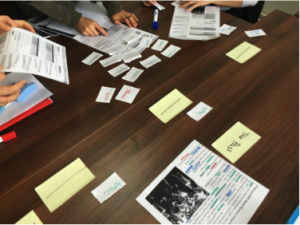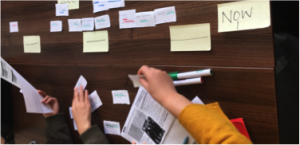I was teaching an intermediate-level Preparatory English class today (before students start on a foundation or pre-masters programme) and found myself wishing I had a set cuisenaire rods!
Narrative tenses are notoriously difficult for students to get their heads around, but having looked though the coursebook, prepared my timelines to help explain it to them, along with some extra personalised examples that would help, I thought it would be ok. It’s a really small class, they’re diligent and hard working, they’ll take the time to listen and to read through explanations, they’re not too afraid to ask questions, experiment or give it a go, but it just wasn’t working. I could have killed for cuisenaire rods.
This is what I came up with in the spur of the moment:
It’s just scraps of paper with the verbs from the text used to introduce narrative tenses (Speak Out Intermediate). I got the students to identify and colour code the tenses (matching traditional timelines and examples on the board) was being used on the scraps and in a large photocopy of the text. They then read the story and arranged the scraps in the order the events happened.
With some guidance, they were able to identify the sequence of events, and with extra questioning how the events related to each other (past continuous for background/interrupted action, past simple for interrupting action/sequential actions, past perfect for actions further in the past). By the end of the lesson we were all quite happy that they better understanding of the target language.
Honestly, it was hard going for a moment and I wasn’t sure how we’d come out of it on the other side! For such a relatively simple, spur of the moment idea, it worked quite well. I’d definitely use it again, but this time from the start of the lesson, and with a story that was more familiar to the students.


